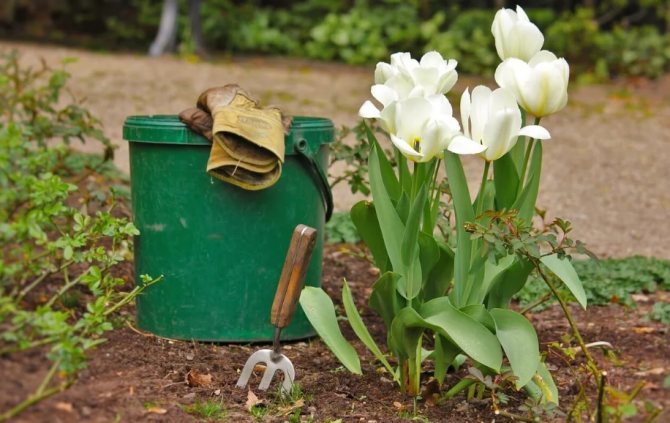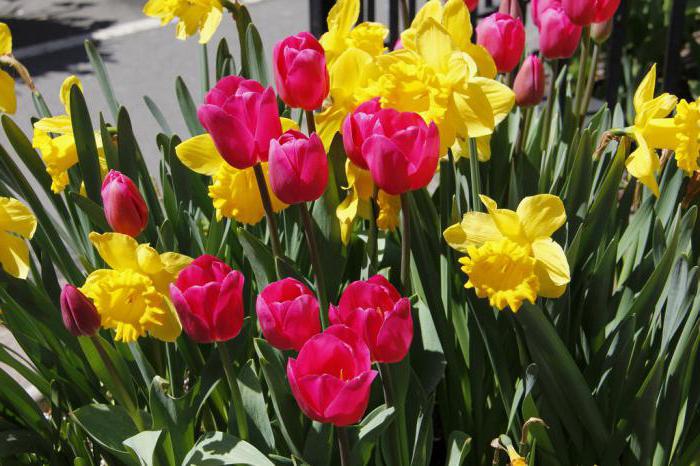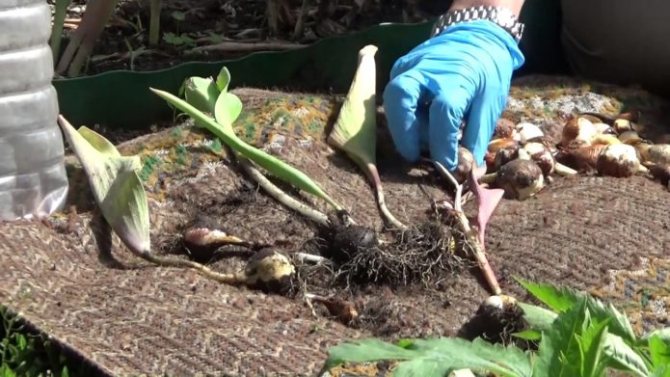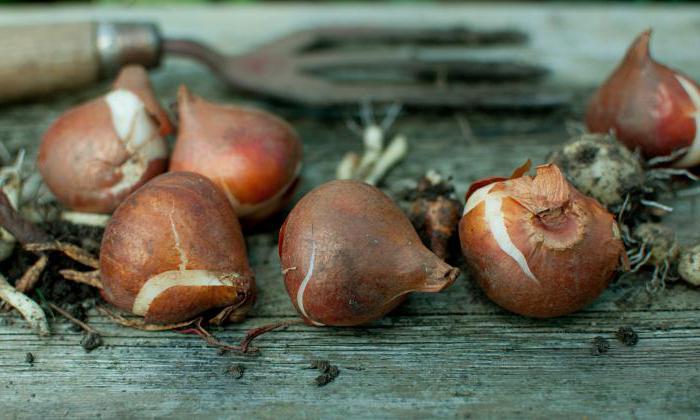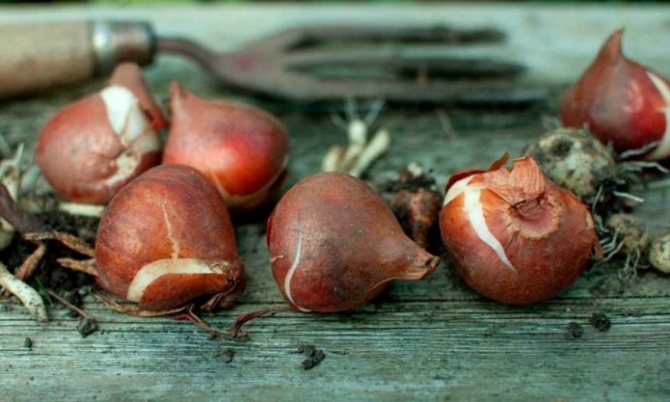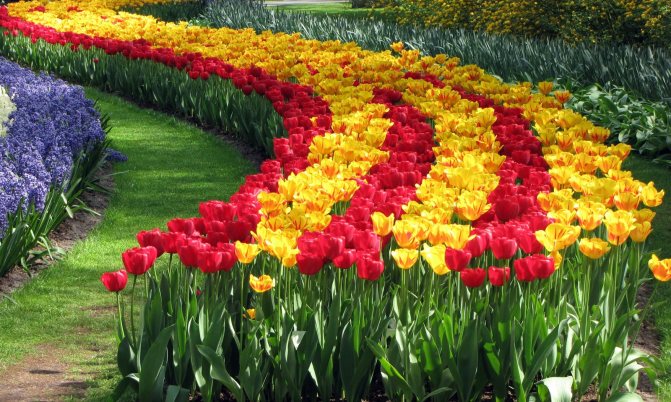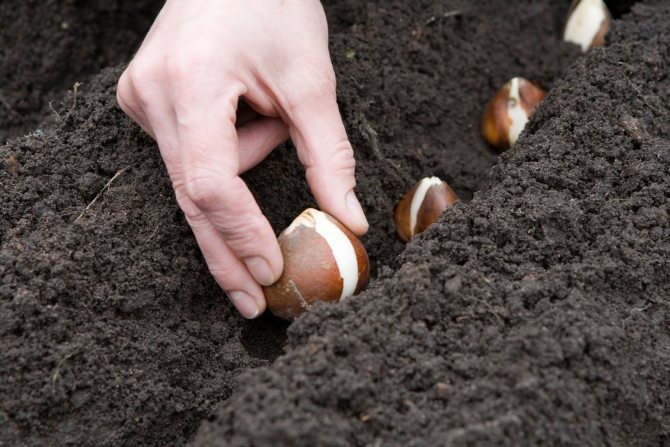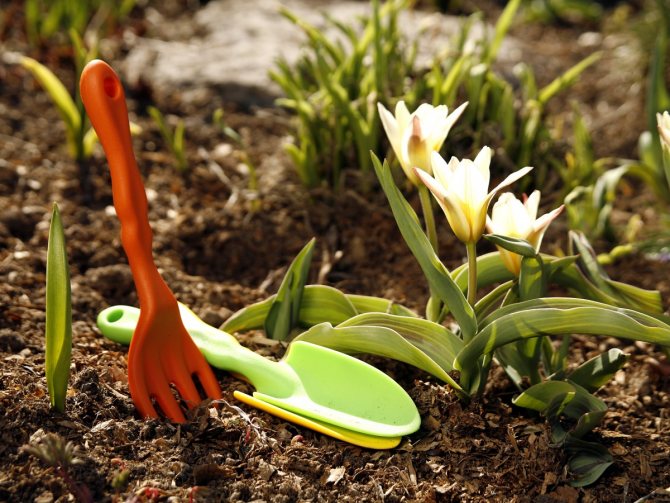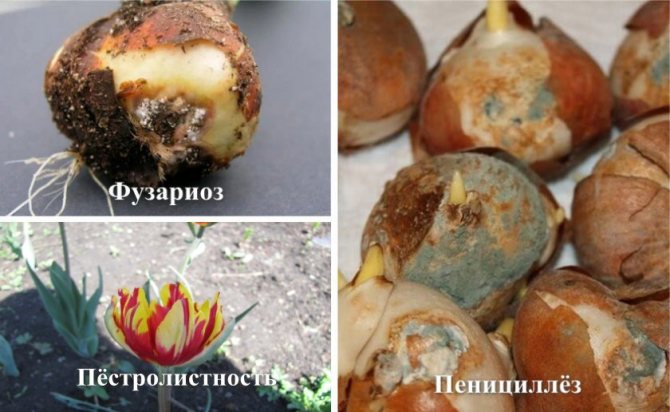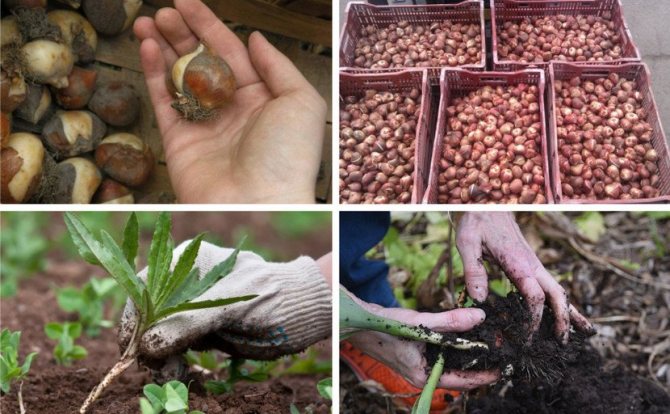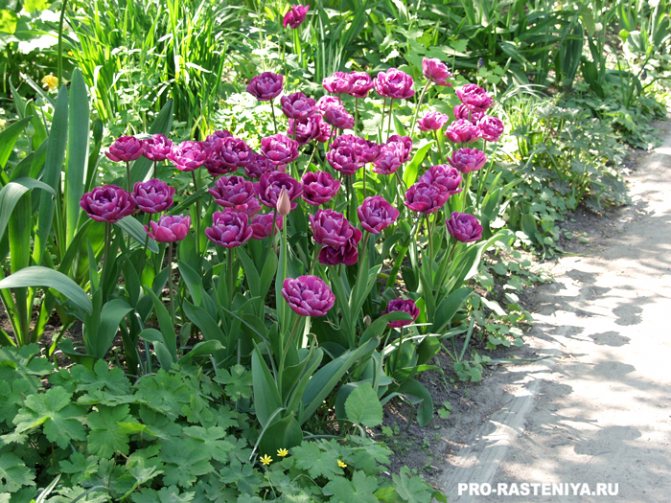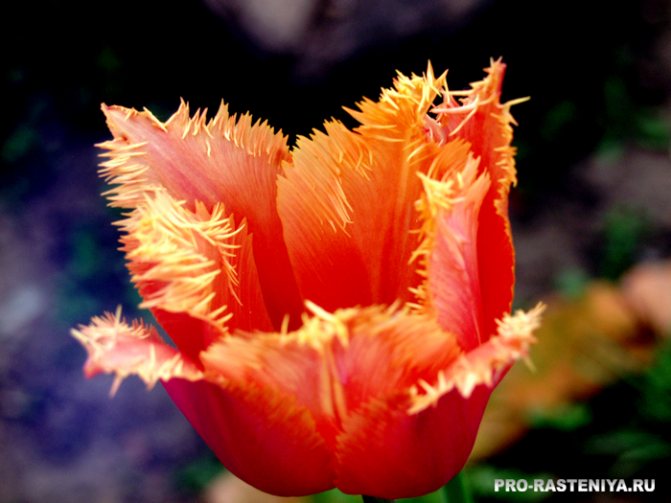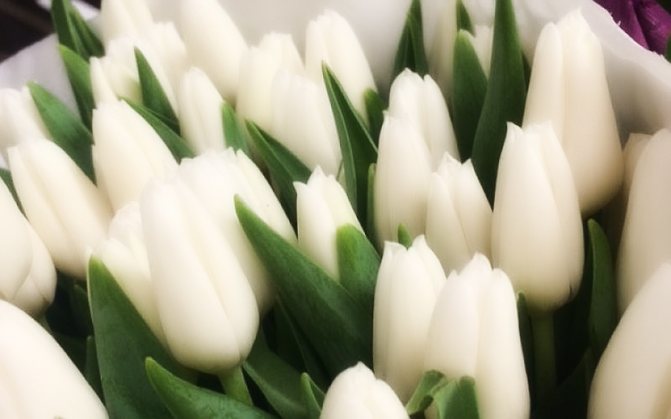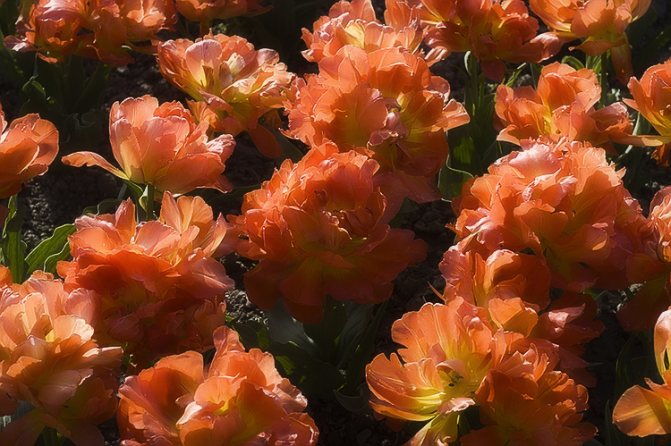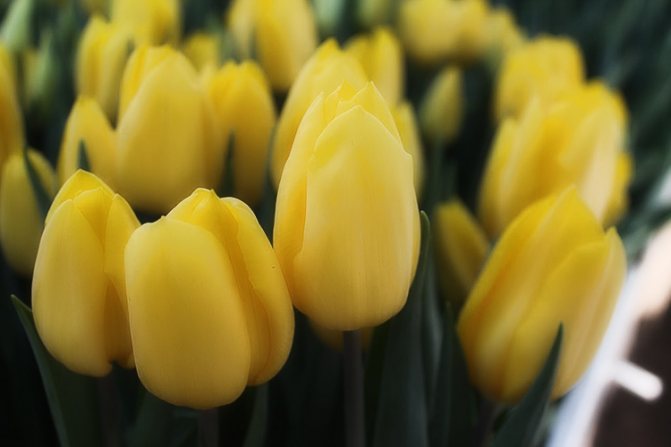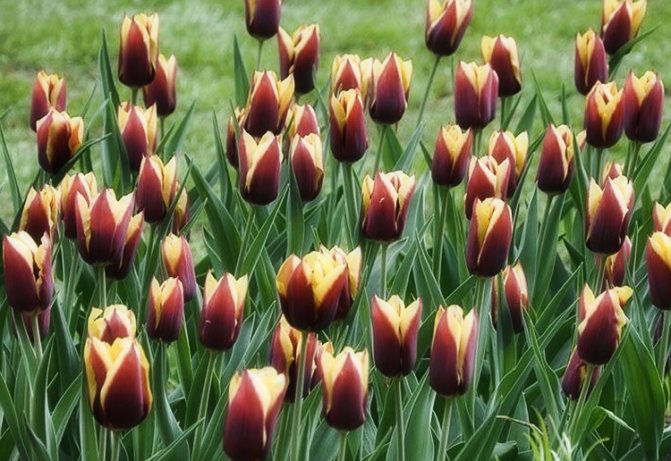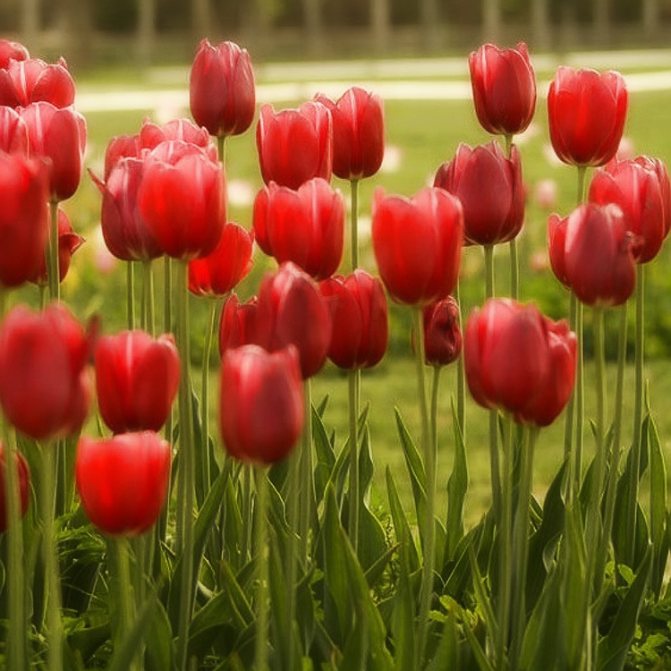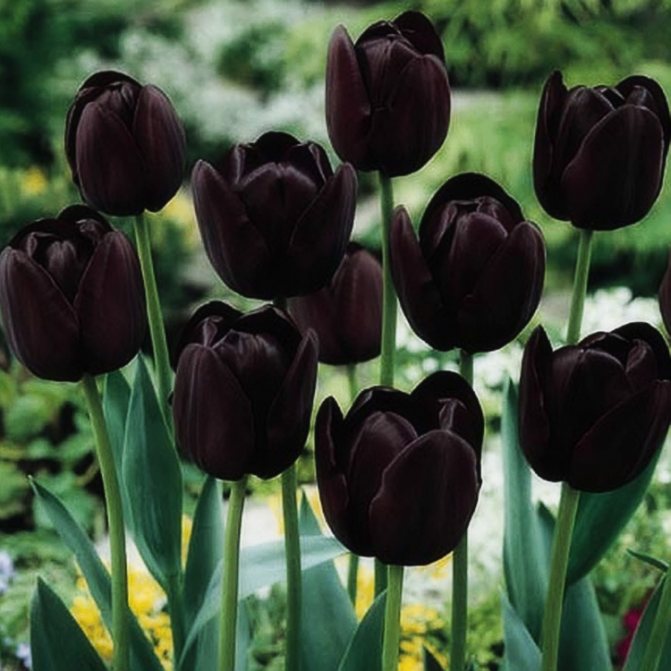Tulips ... Perhaps there are no more plants, the mention of which causes such a mass of positive emotions. Even small children know that with the first spring sun and Mom's holiday, these bright and fragrant flowers always come to the house. Scattering of tulips enliven city squares, village front gardens and numerous summer cottages with juicy strokes, pleasing the eye after boring and gray winter days.
The tulip belongs to the perennial herbaceous bulbous plants of the Liliaceae family. Its height, depending on the group and variety, can range from 10 cm to 1 meter. The region of origin of the species is the mountainous regions, semi-deserts and steppes of Central Asia.
When to dig tulips
Large beautiful flowers will delight if their bulbs are dug out after flowering. When to dig up tulip bulbs, their leaves will tell you.

Tulips in the garden
Important! If you leave the flowers in the ground, they will deepen, and next year the flowering may be delayed, the flowers themselves will become smaller.
Dig up the planting material when the flowers have faded, but do not wait for the foliage to completely wilted, then it will be difficult to understand their location.
Additional care advice
To grow a large bulb or propagate a variety, on the 4-8th day of flowering, you must cut off the flowering head. This measure helps to increase the mass of the bulb.
Remove crumbled petals, yellowed leaves from the garden - they will rot, which contributes to the development of pathogens in the area.
To greatly facilitate the work of caring for tulips, plant them in plastic baskets (there are also special containers for this). After flowering, dig up the containers with the bulbs and move them to a secluded spot for the bulbs to ripen.
How do you know if a tulip bulb is ripe? Dig up one of them and examine carefully. The ripe bulb has superficial scales of a pleasant rich brown color, with a slight glossy sheen.
Compliance with all of the above recommendations for caring for tulips after flowering is the key to chic flowering next season.
What to do when tulips have faded
When to dig up hyacinths after flowering
If the flowers begin to fade, their foliage turns yellow after a while. Tulips have faded, what to do with them next, the aerial part of the plant will tell you. The leaves should be almost completely yellow, but not brittle, flexible enough to adhere firmly to the bulbs.
Important! Do not wait until all the leaves are withered and dry. The location of the bulbs will then become unknown and may be damaged if dug up.


Beautiful flower bed
After digging up, the tulips must be prepared and stored in a suitable place, such as in a house or basement. If you perform all the actions on time and correctly, then the planting material will be able to survive until autumn and will delight you with beautiful flowering in the future.
Tulips need care after flowering outdoors. It is best to dig them up on a warm, clear day. It is best to use a pitchfork or a narrow shovel in your work. In the southern regions of Russia, the procedure can be performed already in early June, in the northern regions and in the middle lane - in early July.
Do not do this too early, they will be poorly stored, and the next year the plant will become less resistant to diseases, the flowers will grind it. If it is too late to complete this procedure, the babies will separate from the mother's bulb and may be damaged or even lost in the soil.
When should you transplant daffodils?
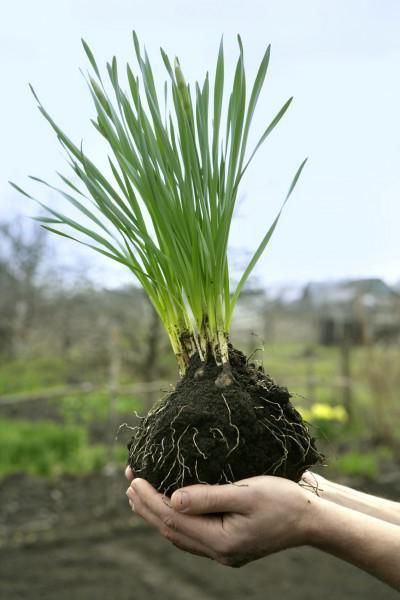

These flowers can live in one place for up to five years. Do not disturb them for an annual transplant, otherwise the plants may not bloom so abundantly. But if the stems begin to get crowded and have already grown quite a lot, then it's time to plant them.
For a transplant, you will need:
- garden shovel;
- gloves;
- disinfecting solution.
Daffodil bushes are planted right away; young roots should not be allowed to dry out. Pick a late afternoon in early August, when the midday heat has subsided, and get started.
What do we have to do?
1) To begin with, the bushes are carefully dug up.
2) Then they are divided into smaller ones and laid out for processing.
3) For prevention, plants can be sprayed with a weak solution of potassium permanganate or a suitable fungicide.
4) In a new place, the holes are prepared and daffodils are transplanted into them with maximum accuracy.
Why dig up flowers in the summer
When to replant tulips
If the bulbs are left in the soil over the summer, they can suffer from excessive heat or heavy rainfall. This will entail irreversible consequences: tulips can go deeper into the ground, get sick or stop blooming altogether.


Tulip bulbs
Important! In a dry and not too hot climate, you can not disturb the bulbs for 1-2 years, only by checking the planting depth, while the fringed species cannot be left in the soil even for one summer.
Top dressing
Intensely growing tulips store and initially use the nutrients of the bulb without forming a powerful root system. Fibrous roots are located close to the soil surface, so complex fertilizers of quick action work best.
It is necessary to apply dry powder or granular fertilizers carefully - if they hit the leaves or buds, they cause burns. It is important to combine any subsurface fertilization with mineral fertilizers with abundant watering.
In a short season, it is enough to spend three dressings, when growing children are limited to two. Overfeeding will not give better flowering, on the contrary, it will worsen the ripening and preservation of the bulbs.
First time feeding they are brought in immediately after the snow melts, as soon as the sprouts appear. During this period, it is convenient to use dry granular fertilizer, for example, Kristalon special. In turn, on heavy soils, as well as with high humidity, Kristalon yellow is recommended, which is especially important in early spring. The Kristalon series is enhanced by the presence of trace elements, of which iron, boron and zinc are the most important for tulips.
When choosing a complex fertilizer for the first feeding, you need to choose a brand with an N: P: K ratio within 2: 2 (1.5): 1. Nitrogen is necessary for strong vegetative growth - the development of the stem and leaves, phosphorus - to strengthen the root system.
Second feeding carried out during the period of peduncle extension and budding, at this stage the nitrogen content is reduced, increasing the concentration of potassium, which is important for the full development of the flower and the rich color of the petals. The N: P: K ratio should be 1: 2: 2, you can successfully use Kristalon red.
Third feeding falls on the completion of flowering and its main role is the full formation of the bulb. For this, phosphorus and potassium are introduced in a 1: 1 ratio, and the presence of nitrogen is minimized or completely eliminated.
To grow high-quality babies, it is enough to complete the first and third feeding, while it is desirable to carry out timely decapitation.
How to prepare bulbs for storage
When to plant tulips
When digging tulips, keep the tools perpendicular to the ground, otherwise there is a risk of damage to the planting material. They must be removed from the ground together with a lump of earth, after which it must be shaken off.
Large children should be separated from the bulb, while leaving the small ones so that they grow up. After that, the tulips should be laid out in boxes (preferably wooden ones):
- immediately take it outside and ventilate, if the weather is rainy, then leave it to dry indoors;
- remove excess dirt and husks;
- rinse them with a solution of salt (1 liter of water and 1 tbsp. l. salt);
- lay in layers in boxes, spreading each row with a newspaper.
Store the bulbs in a dark room, a dry basement is perfect. Good ventilation and disinfection of the room will help. For storage, the temperature should be maintained at a level of up to 25 ° C, humidity - no more than 60%. You can protect the bulbs from mold and rot by airing the selected room twice a week for 3 hours.


Sick onion, this one should be thrown away
Closer to autumn, the temperature should be gradually reduced to 16 ° C, while the airing time is reduced. In such conditions, the rudiments of foliage and buds are formed. Also, the bulbs should be checked regularly for damage and decay. Such specimens should be immediately removed from the rest.
Disease and pest control
Like many other decorative species, tulips are affected by diseases and various pests. The most numerous and harmful are fungal diseases, the pathogens of which feel great in damp spring weather, and it is during this period that the active development of bulbous plants falls.
Gray rot develops rapidly on cool rainy days, rapidly affecting more and more new plants. The source of infection can be both diseased bulbs and soil. Brownish-gray depressed foci appear on the leaves, stems and buds. Affected tissues dry out quickly, become thinner, take on an olive hue and resemble burns.
Tulips stunted, bloom poorly, forming deformed underdeveloped glasses. On the bulbs, gray rot appears in the form of rounded brownish spots with a pinkish-crimson edging, later the tissues soften and rot, the bottom cracks.
Softening of the bulbs, the appearance on them of numerous black sooty foci are signs botrytous rot... Weak leaves are covered with dark brown and black spots, the stems become fragile. More often, the disease affects injured, late planted bulbs.
White rot first develops at the very top of the bulb, resembling a fibrous white bloom. The sprout develops weakly or dies altogether, later the fungus affects all scales. If such a plant does produce shoots, they are often covered with greyish-purple watery spots.
Looks like white rot typhulosis, with the development of which the sprouts do not move forward, remain reddish for a long time. Then the bottom rots, the roots, and the bulb dies.
Malicious and persistent fusarium affects plantings during the growing season, inhibiting the development of plants that produce weak peduncles and ugly, slightly colored glasses. When excavated and examined during storage, Fusarium bulbs are characterized by depressed brown spots with a distinct pink-crimson border. If such specimens are not removed in time, the fabrics will rot, an unpleasant odor appears and the entire batch can become infected. In the soil, the spores of this fungus persist for up to 6–7 years.
Measures to combat fungal diseases the following:
- planting healthy planting material,
- annual extraction of bulbs,
- compliance with the temperature regime during storage,
- regular inspections,
- landing in the same place no earlier than in 4–5 years.
Acidic, heavy soils and high humidity contribute to the development of fungal infections. In addition, it has been noticed that fed tulips are less likely to rot. Potash, phosphorus fertilizers and microelements are especially effective. If lagging behind in growth, ugly, pale, spotty plants or with "blind" buds appear on the garden bed, they are dug up with a lump of earth, taken out of the plot and destroyed.
After harvesting the bulbs, they are kept in a 0.5% solution of potassium permanganate for 30-40 minutes. Before planting, it is worth treating with Fitosporin-M or Fundazol suspension, which is especially effective for fusarium. During the growing season, under unfavorable weather conditions and the threat of an outbreak of fungal diseases, 2-3 treatments are carried out with one of the fungicides.
Variegated tulips
Variegated - the most common viral disease of lily cultures. Variegated tulips are mentioned as early as the 16th century, at the same time attractive features were fixed and varieties classified as fantasy were created. class Rembrandt.
Beautiful flowers really adorn the garden wonderfully, but later it became known that this viral disease is easily transferred from plant to plant. Affected specimens gradually degenerate, develop worse, become smaller over time and are susceptible to fungal diseases.
The virus is carried by sucking insect pests - aphids, midges, thrips... As soon as flowers with variegated petals that do not correspond to the variety have blossomed on the site, they must be immediately dug up and burned, or placed in a hole, sprinkled with lime and buried.
Tulips are annoyed by all kinds of pests that deplete plants, carry diseases, and contribute to fungal infection.
Fine yellowish onion mite bites into the juicy pulp, making moves in the scales, which leads to decay, death of leaves, and weakening of the entire plant. When viewed during storage, voids filled with a brown free flowing powder can be found. Before planting, the affected planting material is kept in hot water (38–40 ° C) for 5–7 minutes or insectoacaricides - Rogor-S, Di-68 and sulfur preparations are used.
Fly larvae onion hoverflies - the scourge of daffodils, hyacinths and other bulbous. Having penetrated through the bottom, the larvae colonize the juicy scales and winter well in the storage, causing the bulbs to rot. If a hoverfly lesion is noticed, after digging the planting material is immersed in insecticide solutions - Arrivo, Bi-58, Decis.
Medvedka - a large aggressive insect up to 5 cm long, omnivorous, mercilessly gnawing the stems of any plants. They destroy insects in late autumn, arranging traps filled with manure in the ground, which they dig when frost comes, throwing a bear on the surface of those who are going to winter. Another good way is to use special baits.
The deep annual digging will hamper the development and wintering of the onion hoverfly, the bear, as well as the larvae of the May beetles;
Long-term cultivation of tulips in the same place invariably leads to weakening, degeneration of plants, infection of the site with pests and fungi.
Digging work procedure
Choosing a dry, warm day, you can dig up the tulips. When working, it is better to focus on dry foliage and carefully remove the bulbs along with a clod of earth.
Important! The bulbs should be carefully removed so that the little children dug up everything and do not get lost in the ground.
If it rained, then you should wait a few days until the earth dries out, only then dig. Having taken the bulbs out of the soil, they must be left for a couple of hours outside in the sun so that the soil on the roots becomes completely dry.After that, they are cleaned and removed to a prepared place.
Tulips in the garden: photo varieties
Caring for tulips after flowering
Once the plants have bloomed, some maintenance will be required, even before the bulbs need to be dug up. Many questions arise about whether to prune the leaves and how to water afterwards.
When to prune tulips
By the end of flowering, watering and fertilization should be minimized. But premature pruning will be dangerous and can also lead to a complete lack of flowering in tulips.
You need to cut off completely wilted leaves. As a rule, this procedure is carried out just before the bulbs are scooped up. Plants must receive the maximum amount of nutrients and ripen; in tulips, this process occurs through green leaves.
Important! The term for pruning a tulip comes 15 days after the tulip has faded.
Another important point is that after pruning, the locations of the bulbs should be marked so that they do not damage them later and know exactly where they are. This whole procedure is a rather lengthy process, which involves the gradual cutting of the aerial part of the flowers, as soon as they are ready.
Do I need to pick a flower
Florists claim that the peduncle should be cut a week after flowering. This will help keep the plant vigorous, conserve more nutrients and form stronger, healthier seeds.
Interesting. When the tulip has faded, in no case should its foliage be cut off. This can provoke the death of the plant. It is recommended to remove only the peduncle, which will provide an increase in nutrients in the seed box.
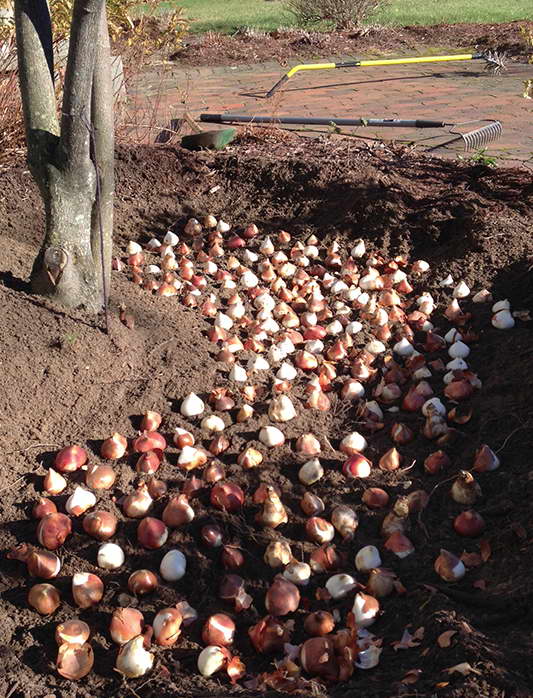

Planting tulips
If the flower is cut for a bouquet, then it is worth cutting it with a couple of leaves. In other cases, the foliage is trimmed only after drying.
Watering
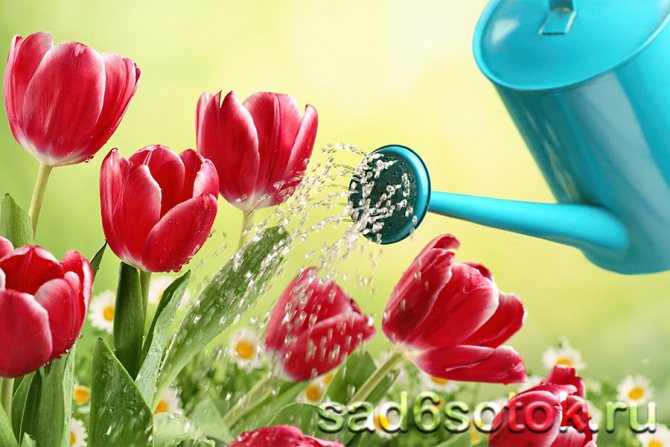

Watering tulips
Due to the shallow roots, tulips are extremely demanding on moisture, but at the same time they do not tolerate stagnant water well. The need for moisture directly depends on the density of the soil and weather conditions - during dry periods, watering is required, and in the rainy season, you can do without them. Light sandy loams require more frequent watering, chernozems and loams, on the contrary, retain moisture longer.
Tulips are watered with sprinkling or drip irrigation, preventing the soil from eroding with a stream of water and exposing the roots. Average consumption - 20-30 liters per sq. m. It is best to water the plants in the morning and in the evening, under the blinding sun, drops of water cause burns on the leaves and delicate petals.
Tulips are most demanding of moisture during the formation of buds and opening of flowers. Optimum hydration during this period promotes the development of large glasses, long flowering, healthy bulbs and babies.
After each watering, as soon as the soil permits, the aisles are loosened and the crust under the plants themselves is destroyed. Do this carefully, keeping in mind the finely spaced thin roots. Cultivators are used to loosen the row spacings before the plants begin to close.
To retain moisture, it is advisable to use mulch - peat, compost, humus or non-woven materials (spunbond, lutrasil), which will maintain a healthy microclimate, moisture and allow the roots to breathe. If mulching is used, there is no need for constant loosening. At the end of flowering, the number of waterings is reduced and gradually they are completely stopped.
Timing of digging tulip bulbs
Flowering times vary depending on the region and variety. Therefore, it is possible to determine exactly when to get the bulbs out of the ground only by the time when the flowering ended. This process begins no earlier than a month after flowering. Do not keep tulip bulbs in the ground for longer than 1.5 months after they are fully ripe.
Important! Digging the bulbs is useful, the main thing is it helps to grow large and beautiful flowers.
The cultivation of tulips in Belarus and the Moscow region is not much different, in the Urals and Siberia the timing will be completely different. In the Kuban, the period will be earlier than in other regions.
Plant features
The tulip is a typical bulbous. At the moment, there are more than 3500 varieties of this beautiful flower. However, there are only about 150 popular and often grown ones. Tulips can have different peduncle heights, petals of different shapes. You can grow parrot, peony, lilac and other varieties of these flowers. Tulips bloom from early spring to early summer. However, modern agricultural techniques allow you to get beautiful buds almost all year round. Tulips vary in color. However, in kitchen gardens and orchards, red, yellow, pink and striped varieties are most often seen.
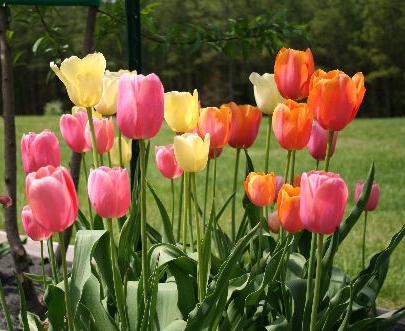

How and how much to store planting material
Store the bulbs in a special place where the required temperature, humidity and low light must be maintained. The room should be well ventilated or regularly ventilated.
For about 2 months, the temperature should be maintained no higher than 25 ° C, after which it should be gradually reduced to 15 degrees. This care helps to form a flower bud in the tulip bulb.
Attention! It is worthwhile to regularly sort out the bulbs, remove the bad and rotten ones, and also just wiggle them.
Landing in the ground
Ideally, tulips are planted in the soil in the fall., in late September - early November. Spring disembarkation is also practiced, in April. But then the tulips will bloom much later, because they will need about three weeks to root. It is advisable to change the planting site every year so that pathogens do not accumulate in the soil.
Where spring flowers will grow, moisture should not stagnate. The future flower bed is prepared in 2 weeks so that the earth settles evenly. The bed is dug to the depth of the shovel bayonet and compost, ash or superphosphate are added. Lime if necessary. On clay soils, the introduction of peat is encouraged. In the absence of rain, the area is spilled with water.
Before planting, the bulbs are sorted out again and disinfected in a solution of potassium permanganate. The planting depth of the bulb is three times its height. For large specimens, the distance between the bulbs is 15 cm, for medium ones - 10 cm, small ones - 5 cm. 25-30 cm is left on the row spacing.
Do not cover the flower beds with organic matter so as not to attract rodents. With the onset of unforeseen frosts, agrofibre is spread on the flower bed, which is pressed by boards.
On the advice of an experienced grower, when planting, I put a handful of sand mixed with ash in the hole. I put an onion on this "hill" and cover it with earth. Now the loss of tulips from various rot on my heavy loam is minimized. And the bulb comes out larger, due to the fact that the sand loosens the soil and the roots develop freely.
Top dressing immediately after flowering, disinfection of bulbs and warm storage with a subsequent decrease in temperature - these are the three whales of the grandiose spring flowering of tulips.
When and how to plant tulips in autumn
Interesting. Tulips are planted in autumn, then in spring you can admire their incredible flowering and enjoy the aroma.
October is suitable for planting in the ground, in colder regions this should be done in September. It is important for the bulbs to take root during the warm period, this will help them to take root, which will ensure a warm winter and bright flowering in spring.


Tulips in a bouquet
The soil temperature should be no higher than 10 ° C. For later planting, cover the tulips to allow time for rooting. If the ground is not cold enough, then rooting will take place more slowly, and pests and diseases can also affect the bulb.
Interesting. Both early planting of tulip bulbs and late planting are harmful.In the first case, there is a risk of disease, in the second, the plant will not have time to develop before frost.
For tulips, you should choose sunny, windless areas; light sandy soil is required. To improve the condition of the soil, compost or peat can be added. Drainage should be placed in each hole at the bottom, the soil should be dug at least 30 cm deep to saturate it with oxygen.
Interesting. Tulips are very fond of various kinds of fertilizers, but when planting, it is worth using only complex fertilizer for bulbous plants.
The planting process is as follows:
- make furrows 15 cm deep;
- spill them with water;
- then it is worth feeding the plant;
- lay out the bulbs at a distance of 10 cm;
- sprinkle with ash and sand;
- then sprinkle with soil.
It is best to plant tulips in the same place only after 4 years.
Sometimes an urgent transplant is required in the spring. For example, if you need to plant other flowers on this place. You can transplant tulips, but it is advisable to do this before flowering. Caring for tulips is simple, the main thing is to do all the actions correctly.
Storage
During summer storage, the bud and buds of future bulbs are finally formed. In order for the maturation process to take place correctly, they are first kept for a month at a temperature of about 25 ° C in a well-ventilated room. The optimum humidity is 60–70%. In August, the temperature is lowered to 20 ° C, in September and further down to 15 ° -17 ° C.... If these rules are not followed, tulips may not bloom or give "blind" buds.
Periodically, the planting material is examined and discarded by sick or moldy ones. Most often stored tulips are affected by gray rot and fusarium. At the first disease, the bulbs become covered with a gray coating and gradually rot. In the second case, brown spots with a brownish border are formed, the bulbs exude an unpleasant odor and also decompose. If the lesion is small, the rot is cut off with a sharp knife, the onion is pickled, as usual, then sprinkled with ash and dried.
Choosing a place for planting tulips
So, first you need to choose a suitable place for planting planting material. First of all, pay attention to the quality of the area lighting. Tulips love a large amount of light, without a sufficient amount of it, the plant will stretch out, and the inflorescences themselves will become small and lose their color.
If you decide to make a composition with tulips, be sure to consider this point. Other plants should not shade tulips. The site for planting must necessarily be flat - the flowers react extremely negatively to changes in height, as well as to stagnant water. Hence another rule follows - the landing site should be with good drainage, even. The soil must be chosen as light as possible. If you don't have one on your site, just add expanded clay, river sand and a little sphagnum to the soil, then dig it up.


If the soil is poor enough, fertilize it. For example, rotted compost, ash or chicken manure infusion. Tulips are extremely sensitive to the content of nutrients - without the required amount, the bright color of the inflorescences is lost.
Fertilization
Top dressing of tulips with fertilizers is carried out in the active growing season three times. This is done immediately after watering:
- The first fertilization is performed when the plant has reached a length of 5 cm. The crushed top dressing is distributed between the rows and embedded in the soil. It is best to perform this procedure in the morning. To do this, use nitrogen fertilizers, phosphorus and potash in a ratio of 2: 1: 1.
- The second feeding is performed during the period of bud formation. Fertilizers are dissolved in water and applied to the soil through the grooves. This time, the proportions should be 1: 2: 1.
- For the third time, tulips are fertilized during the flowering period, but no later than 1.5 weeks after the previous one.It is carried out according to the principle of the second feeding.
Important! On large-scale plantings, fertilizers are applied only in dry crushed form. They are poured over the wet soil surface after watering, then embedded in the soil when loosening.
Testimonials
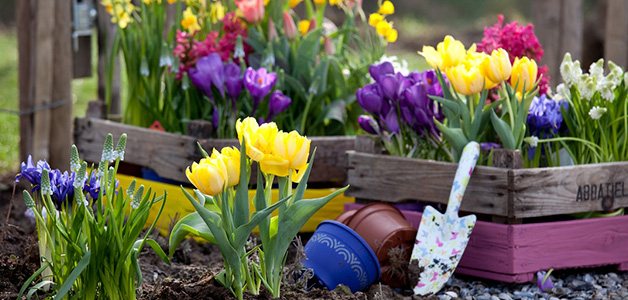

Tulips are suitable for single and multi-species flower beds, they look decorative when planted in pots. These plants require special care. Gardeners note that it is extremely important to observe the irrigation regime, since drought and excess moisture are badly reflected in the state of buds and leaves.
Regular digging of bulbs is a significant disadvantage of growing all lily crops. The procedure should be performed within a clear time frame, otherwise the bulbs quickly lose their germination capacity and begin to hurt. In addition, during the growing season, you should carefully examine the planting for the presence of diseases and pests.
What varieties are suitable for forcing
Tulips, cultivation and care of which in summer consist mainly of watering and fertilizing, bloom in a warm room in winter. Beautiful buds can be obtained both by the New Year and by March 8. In this case, it is important to choose the right variety. So, for obtaining tulips in December-January, the varieties Brilliant, Dixis, Star, Marvel, Olga and others are perfect. By February-March, Darwin's hybrids may bloom: London, Diplomat, Parade. By April, such varieties are driven out as America, Vivex, Oxford, London. By May 1, you can get flowers from Parade, Oxford, Hibernia.
Preparing for landing
An important component of preparing for planting flowers is the correct choice of a site for a flower bed. To do this, they are guided by the following rules:
- heavy soils and sandy soils are not suitable for tulips, they need sandy loam soils rich in humus;
- on clayey areas, the situation can be corrected by introducing river sand;
- overly light soils add sod land, peat, humus;
- the site must be closed from the wind;
- tulips develop well in places sufficiently illuminated by the sun, otherwise the bulbs of the plant become smaller;
- late varieties can be planted in partial shade;
- the site should be even, flowers grow poorly on the slopes;
- a favorable condition for the growth of tulips is the high standing of groundwater.
Important! Although tulips require high groundwater, stagnant water negatively affects plant health. In such conditions, they are more susceptible to fungal infection. Therefore, the topsoil must be well aerated. For this, drainage ditches are additionally arranged.
The selected area must be properly fertilized. It is important not to overdo it here. An excess of organic matter negatively affects flowering - the petals become irregular, the peduncles are bent.
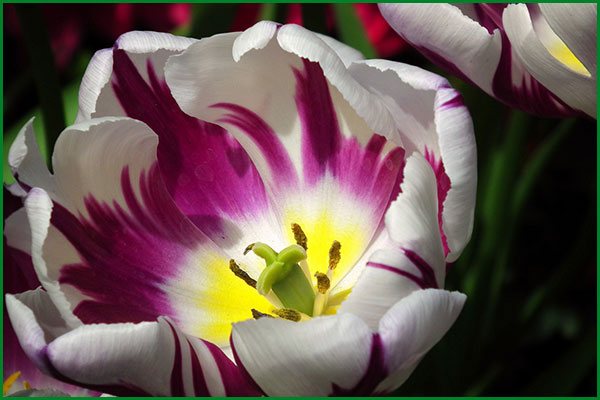

Rembrandt tulips
It is unacceptable to apply fresh manure under the bulbs, because of this they rot and lose their ability to reproduce.
Soil preparation is carried out in the following sequence:
- The soil is preliminarily limed, since neutral or slightly alkaline soils are suitable for tulips.
- For 2-3 months before planting, mature humus is added to the ground.
- A good effect of flowers is the introduction of 2-year-old compost.
- If it is necessary to improve the soil, the selected place is sown with green manure before planting.
- Subsequently, the cut siderates are plowed into the ground.
Choice of place and conditions of detention
Tulips are a whimsical thermophilic crop, the abundance of flowering and plant health largely depend on the growing conditions. For all species, the conditions of keeping are similar, the variety affects only the appearance, the plant's resistance to cold and disease.
Lighting and location
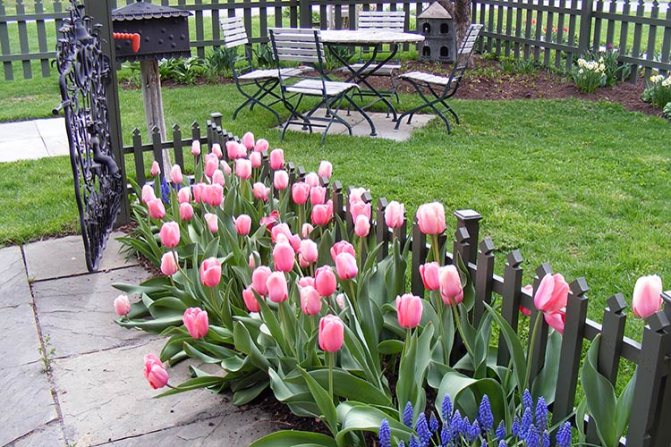

The site for planting tulips should be sunny, with constant access to light and protection from drafts, wind, especially for tall varieties. Flowers are not suitable for growing in the shade of large trees, next to tall fences.Long-term exposure to the sun has a positive effect on the formation of buds, the intensity of their color.
It is advisable to give preference to flat beds, where water cannot penetrate below the fertile layer. The root system can go deep into the soil up to 70 cm, so it is undesirable to plant bulbs in places with a high groundwater table.
Temperature
For active growth and flowering, tulips require a high temperature, these are heat-loving plants that are found in the wild in Asia. As a rule, planting is carried out in the fall (first decade of September) at a temperature in the range of 6-10 ° C.
When planting, it is important to take into account the peculiarities of the climate in the region, it takes 2-3 weeks to form the root system, during this period there should be no threat of frost. Flowering begins in spring, when the air warms up to 15-17оС.
Air and humidity
The increased humidity of the air and soil adversely affects the development of tulips. There is a risk of root rot development, the process of flower formation slows down. The moisture level can be controlled by the irrigation regime, as well as by a competent choice of a place for planting. Tulips are able to withstand slight drafts before the beginning of the growing season, the regular cold wind has a bad effect on the state of flowers.
Priming
Tulips prefer loose and fertile soil with a good drainage system. It is best to plant plants on loam or sandy loam enriched with organic matter. The acidity of the substrate should be neutral; for some varieties, a slightly alkaline medium is recommended. It is not recommended to plant tulips in swampy and clayey soils, as high humidity has a detrimental effect on the health of the bulbs.
Crop rotation is of great importance. You should not plant tulips in the area where bulbous and nightshade crops were previously grown - they have common diseases. To improve the quality of flowering, one year before planting, the site can be sown with green manure plants (legumes, clover, or alfalfa), and then dug up along with the soil.
What kind of soil do tulips love
Tulips are not very picky about the quality of the soil, but more like sandy loam or loamy, light, fertile, oxygenated and sufficiently moist. The acidity of the soil should be weak or neutral. If its level is higher than the norm, it is imperative to add lime to the soil.
Did you know? Tulip, garlic and asparagus belong to the same family.
Groundwater should be at a distance of at least 60 cm from the surface of the earth, since these flowers do not really like high humidity and do not tolerate swampiness. It is not recommended to grow tulips in the same place every year, it is advisable to constantly replant them. You can return to the previous flower bed no earlier than after 5 years.


Advice
- It is not recommended to propagate tulips by seeds. This is a long procedure, there is a risk of plant death at any stage of development.
- There are a huge number of tulip petal blossoms, due to which you can create a real pattern of flowers on the site.
- The flowers can be used for sale in cut form. They stand for a long time, they are always in demand.
- You can determine the need for digging by the state of the leaves. Experienced gardeners recommend carrying out the procedure when 2/3 of the length of the leaf plate turns yellow.
Reproduction
For those who want to plant tulips, propagation of these flowers will not cause any particular difficulties. Planting is carried out from the second decade of September to the first decade of October. Flowers are placed on flower beds and flower beds, both separately and in combination with other bulbous.
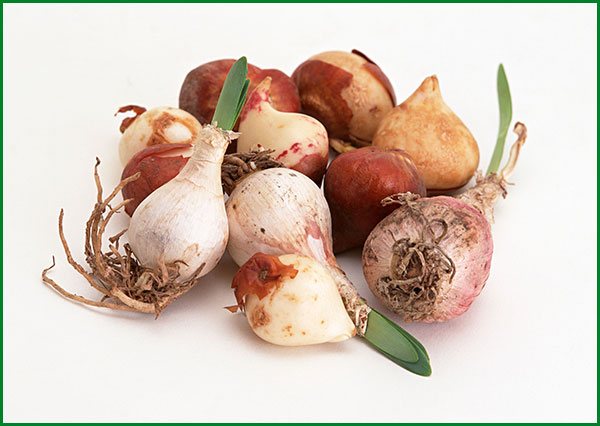

Tulip bulbs
The bulbs must be sorted before planting:
- Arrange them by size.
- Those affected by disease and mechanical damage are discarded.
- Hide healthy specimens in linen bags or paper bags.
- Be sure to make a note with a description of the variety.
Important! Flowers are planted separately on the beds, which are intended for cutting. For this, small bulbs are used. Large planting material is intended for flower beds, where it is planned to grow other bulbous plants as well.


